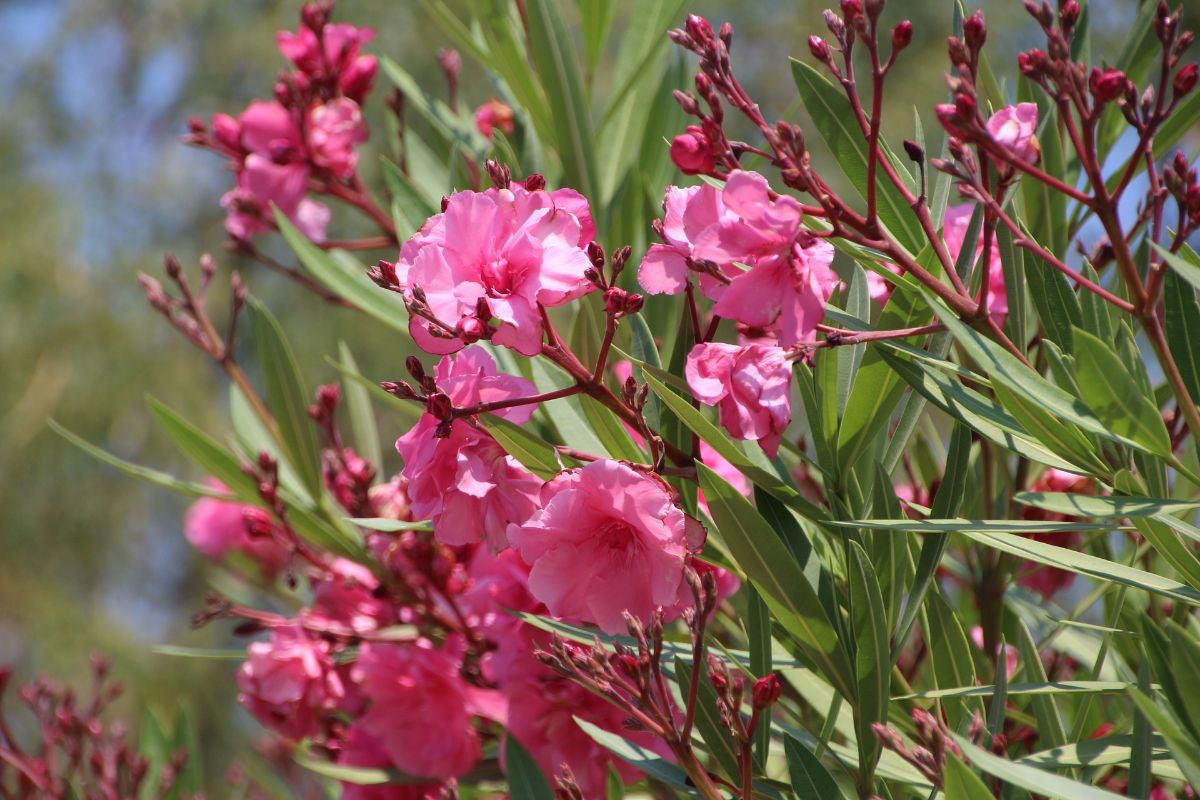
It tienes an oleander you will know that this bush is one of the most beautiful, especially for the colorful flowers that it offers you. But, if you don't cut it from time to time, that little bush can easily reach 3 or 6 meters high. Therefore, to control it, many know that one of the care they must do is prune it. But how do you prune an oleander?
Either because you have one at home and you want to know how to cut the branches so that it is strong and healthy (and thus flourishes more); or because you want to put it at home and you are seeing what its care is, here you will be able to know what the steps are to prune it.
When to prune an oleander

The first thing you should know about pruning oleander is when to do it. As a general rule, the actual pruning is done once a year. But this does not mean that, during the year, you cannot cut some branches, for example because they come out of the formation that you have created for this bush.
The perfect time to prune an oleander greatly differs from where you look. Some tell you that at the end of summer, others at the beginning of autumn and others recommend you wait until the beginning of spring, before the plant begins to activate. Which one would be right? Everyone.
And, Depending on the climate and temperature where you have it, it is preferable to wait or not for the beginning of a new flowering.
What is clear is that, when it comes to pruning drastically, it is important that it is not in bloom (something that happens from June to September or October). Another thing is to cut a branch, you can do that in those months.
The steps to prune an oleander

Next we are going to give you the keys and steps to prune an oleander with guarantees that it will sprout again and have flowers. Yes, you must be careful because, although it is one of the most beautiful plants, it is also very toxic and precautions must be taken when pruning it.
Have the necessary tools at hand
One of those tools are gloves. It is important that, when handling the plant, you have gloves on to prevent your skin from being irritated by contact with the bush.
In addition, you must have a pruning shears and protective glasses. And we recommend that you also wear a long-sleeved shirt so that there is no part of your skin that can touch the plant.
If your bush is large, you may need a ladder to reach the highest points.
Choose the type of pruning you are going to do
As we have told you before, we could say that there are two types of pruning: the drastic one that is carried out once a year; and maintenance, which can be done at any time.
Now you can actually do three types:
- Maintenance pruning. It is the one that is done at any time and its objective is to keep the oleander healthy and eliminate those branches, shoots and elements that harm the plant (for example, suckers). What is done is to cut as close as possible to the stem or the ground avoiding damaging it and always diagonally so that the water does not stagnate in that area and can rot the plant through that wound.
- Drastic pruning. It is the one that is carried out annually with the aim of cleaning up the plant and eliminating those dead or weak branches that steal energy.
- Flowering pruning. It is also done annually and seeks to increase flowering. To do this, only the branches that have flowered that year are cut, two nodes above the ground, as well as those that intersect or look too thin. The stems that have not flowered are left as they are unless one is very long and you want to give the bush a balanced shape.
What to cut when pruning an oleander
In the case of maintenance pruning and drastic ones (annual ones), this is where you should emphasize).
- Cut the shoots from the base of the plant. Oleander is a shrub that grows new shoots from its roots. The problem is that these take a lot of the energy from the plants and will prevent them from blooming. So, if you remove them, you will be helping it to grow strong. In addition, it is recommended that it not have too many stems to direct growth properly and also to better distribute energy.
- Cut the stems. You must make sure that it is always at the height you want. Oleanders grow very fast and that allows you to cut almost without fear. In addition, what this type of cut does is encourage branching and growth, which means that, even if you lose a plant, in a short time you will have it more leafy.
- Goodbye buds and dead branches. Not only those, but also those that do not look good, that are sick or have pests, etc.
- Check the formation that the plant has. Because you may want a certain shape for her, and it's time to get her to give it to you. Throughout the year you will have to touch up, but in general it is annually when you can cut more.
What to do after pruning an oleander

Once you have finished pruning an oleander, especially if this has been a drastic pruning, it is important that you carry out a series of steps that help the plant maintain its health and de-stress. For it,
- Make sure to fertilize a little. It is to provide some nutrients. We recommend that it be a fertilizer rich in nitrogen.
- Water the oleander. Of course, do not soak it too much because, although it is usually resistant, it does not tolerate excess water.
Lastly, you have to make sure clean all tools well, especially if you use them for other plants, so that the toxicity of the oleander does not affect others. And to wash your hands, because even if you wear gloves, it doesn't hurt to wash them (in fact, a shower is even preferable).
Do you have doubts about how to prune an oleander? Ask us if it is so.